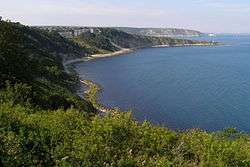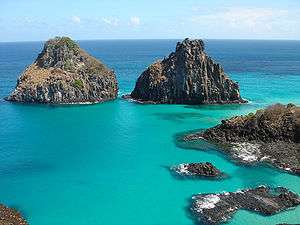Discordant coastline

A discordant coastline occurs where bands of different rock type run perpendicular to the coast.
The differing resistance to erosion leads to the formation of headlands and bays. A hard rock type such as granite is resistant to erosion and creates a promontory whilst a softer rock type such as the clays of Bagshot Beds is easily eroded creating a bay.
Part of the Dorset coastline running north from the Portland limestone of Durlston Head is a clear example of a discordant coastline. The Portland limestone is resistant to erosion; then to the north there is a bay at Swanage where the rock type is a softer greensand. North of Swanage, the chalk outcrop creates the headland which includes Old Harry Rocks.
The converse of a discordant coastline is a concordant coastline.
Examples
- The coastline around Swanage (50°36′24″N 1°57′54″W / 50.60667°N 1.96500°W) is an example of a discordant coastline.


